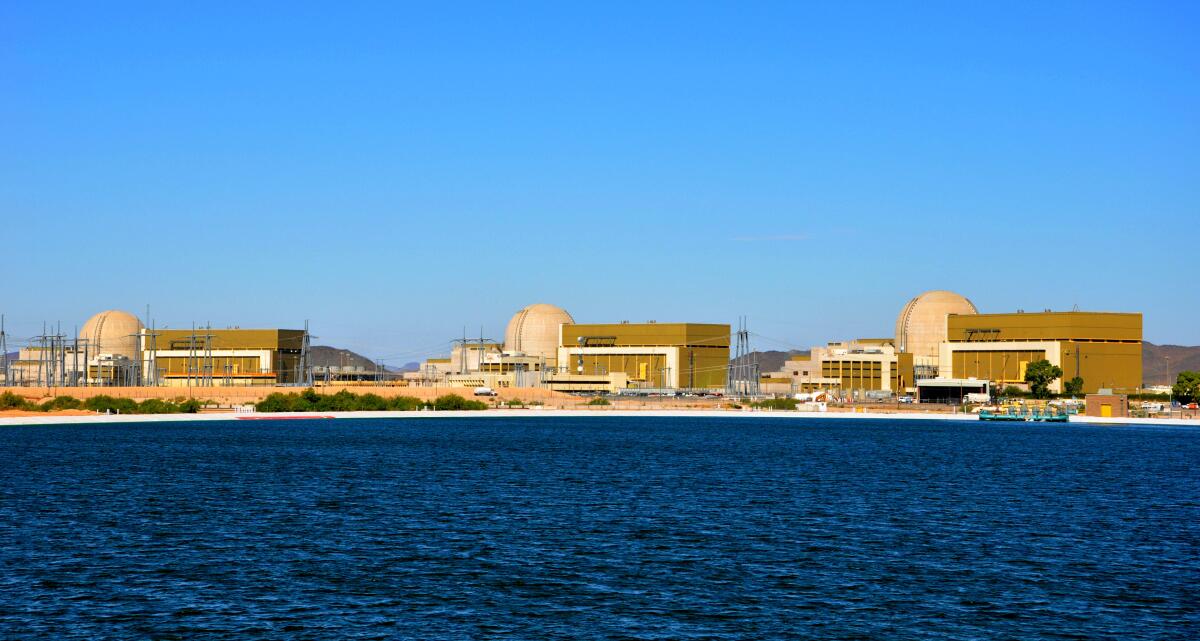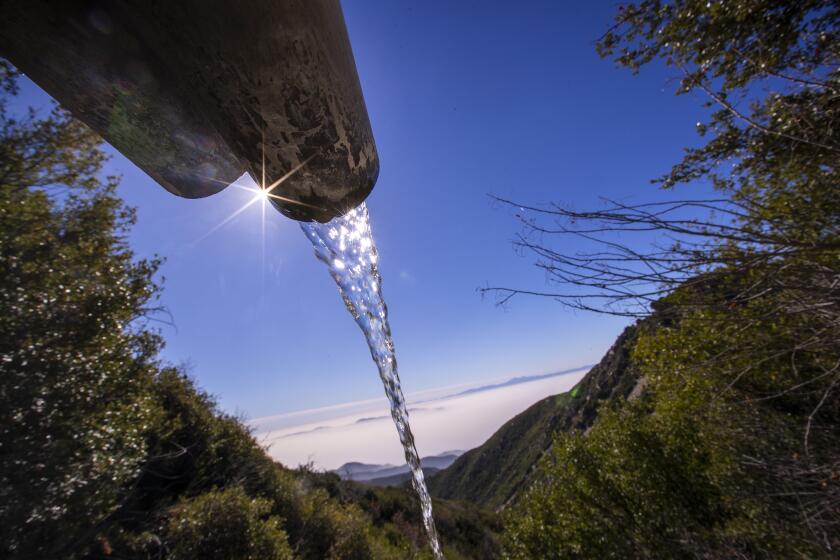Nuclear reactors help power Los Angeles. Should we panic, or be grateful?

- Share via
The radiation containment domes at Arizona’s Palo Verde Generating Station were, truth be told, pretty boring to look at: giant mounds of concrete, snap a picture, move on. The enormous cooling towers and evaporation ponds were marginally more interesting — all that recycled water, baking in the Sonoran Desert.
You know what really struck my fancy, though? The paintings on conference room walls.
You're reading Boiling Point
Sammy Roth gets you up to speed on climate change, energy and the environment. Sign up to get it in your inbox twice a week.
You may occasionally receive promotional content from the Los Angeles Times.
There were five of them, each representing one of the far-flung Southwestern cityscapes powered by Palo Verde. Two showcased Arizona: one for the Phoenix metro area — saguaro cacti and ocotillo in the foreground, freeway and skyscrapers in the background — and one for the red-rock country to the north. Another showed downtown Albuquerque. A fourth portrayed farm fields in El Paso, likely irrigated with water from the Rio Grande.
Then there was an image that may have looked familiar to Southern Californians: Pacific Coast Highway, twisting through a seaside neighborhood that looks very much like Malibu before the Palisades fire.

That’s right: If you live in Los Angeles County, there’s a good chance your computer, your phone, your refrigerator and your bedside lamp are powered, at least some of the time, by nuclear reactors.
The city of L.A., Southern California Edison and a government authority composed of cities including Burbank, Glendale and Pasadena all own stakes in Palo Verde, the nation’s second-largest power plant. In 2023, the most recent year for which data are available, the plant was L.A.’s single largest energy source, supplying nearly 14% of the city’s electricity. The reactors supplied just over 9% of Edison’s power.
During a tour last month, I walked past the switchyard, a tangle of poles and wires where energy is transferred to power lines marching west and east. When all three reactors are running, the yard can transfer “the equivalent of half of the peak [electric demand] of the state of California on its hottest day,” according to John Hernandez, vice president of site services for utility company Arizona Public Service, which runs the plant.
“So it is a massive, massive switchyard,” Hernandez said.
For all the heated debate over the merits of nuclear energy as a climate change solution, the reality is it’s already a climate change solution. Nuclear plants including Palo Verde generate nearly one-fifth of the nation’s electricity, churning out 24/7, emissions-free power. Shutting down the nuclear fleet tomorrow would cause a giant uptick in coal and gas combustion, worsening the heat waves, wildfires and storms of the climate crisis.
Phasing out the nation’s 94 nuclear reactors over a period of decades, on the other hand, might be manageable — and there’s a case to be made for it. Extracting uranium for use as nuclear fuel has left extensive groundwater contamination and air pollution across the Southwest, especially on tribal lands, including the Navajo Nation.
“When we talk about nuclear, thoughts often go toward spent fuel storage, or the safety of reactors themselves,” said Amber Reimondo, energy director at the Grand Canyon Trust, a nonprofit conservation group. “But I think an often overlooked piece...has been the impacts to those who are at the beginning of the supply chain.”
Reimondo participated in a panel that I moderated at Palo Verde, part of the annual conference of the Society of Environmental Journalists. She noted that the nation’s only active conventional uranium mill — where uranium is leached from crushed rock — is located in Utah, just a few miles from the Ute Mountain Ute Reservation.

Even during the Biden years, Reimondo said, it was tough to overcome bipartisan enthusiasm for nuclear energy and “get folks to take seriously the impacts that [tribal] communities are feeling” from mining and milling.
“We just haven’t reached a place in this country where we are listening to these folks,” she said.
That dynamic has remained true during the second Trump administration. Just this week, Interior Secretary Doug Burgum said his agency would fast-track permitting for a uranium mine proposed by Anfield Energy in Utah’s San Juan County, completing the environmental review — which would normally take a year — in just 14 days.
Burgum and President Trump, like Biden-era officials before them, say it’s unwise for the U.S. to rely on overseas suppliers for nearly all its uranium. But many environmental activists, even some who are fans of nuclear, believe running roughshod over Indigenous nations and public lands is disgraceful. And counterproductive.
Victor Ibarra Jr., senior manager for nuclear energy at the nonprofit Clean Air Task Force, said rebuilding the U.S. nuclear power supply chain will require local buy-in — on the front end, where uranium is mined, and on the back end, where spent fuel is stored. Thus far, political opposition has derailed every attempt to build a permanent fuel storage site, meaning nuclear waste is piling up at power plants across the country.
If there’s any hope for more uranium mining and power plants, Ibarra said, it will involve a lot of conversations — conversations that lead to less pollution, and fewer mistakes like those made during the 20th century.
“I think it’s really unfortunate that the nuclear industry has behaved the way it has in the past,” he said.
The benefits of nuclear reactors are straightforward: They generate climate-friendly electricity around the clock, while taking up far less land than solar or wind farms. If building new nuclear plants were cheap and easy — and we could solve the lingering pollution and safety concerns — then doing so would be a climate no-brainer.
If only.
The only two nuclear reactors built in the U.S. in decades came online at Georgia Power’s Vogtle plant in 2023 and 2024, respectively, and cost $31 billion, according to the Associated Press. That was $17 billion over budget.

Meanwhile, efforts to build small modular reactors have proved more expensive than large nuclear plants.
“It would really be quite unprecedented in the history of engineering, and in the history of energy, for something that is much smaller to have a lower price per megawatt,” said Joe Romm, a senior researcher at the University of Pennsylvania’s Center for Science, Sustainability and the Media. “We try to make use of the economies of scale.”
Those setbacks haven’t stopped wealthy investors including billionaires Bill Gates and Jeff Bezos from bankrolling efforts to bring down the cost of small modular reactors, in hopes that mini-nuclear plants will someday join solar panels and wind turbines as crucial tools in replacing planet-warming fossil fuels.
I hope they succeed. But I’m not going to spend much time worrying about it.
For the record:
9:45 a.m. May 16, 2025An earlier version of this column used the wrong name for a nuclear plant in Washington state. It’s Columbia Generating Station, not Centralia. Centralia is a coal plant.
Like I said earlier: Love it or hate it, nuclear is already a huge part of the nation’s power mix, including here in L.A. We’ve lived with it, almost always safely, for decades — at Palo Verde, at Washington state’s Columbia Generating Station, at the Diablo Canyon plant on California’s Central Coast. Nuclear, for all its flaws, is hardly the apocalyptic threat to humanity that its most righteous detractors make it out to be.
It’s also not the One True Solution to humanity’s energy woes, as many of its techno-optimist devotees claim it to be. There’s a reason that solar, wind and batteries made up nearly 94% of new power capacity built in the U.S. last year: They’re cheap. And although other technologies will be needed to help solar and wind phase out fossil fuels, some researchers have found that transitioning to 100% clean energy is possible even without nuclear.
So what’s the answer? Is nuclear power good or bad?
I wish it were that simple. To the extent existing nuclear plants limit the amount of new infrastructure we need to build to replace fossil fuels: good. To the extent we’re unable to eliminate pollution from uranium mining: bad. To the extent small reactors might give us another tool to complement solar and wind, alongside stuff like advanced geothermal — good, although we probably shouldn’t spend too much more taxpayer money on it yet.
Sorry not to offer up more enthusiasm, or more outrage. The climate crisis is a big, thorny problem that demands nuance and thoughtful reflection. Not every question can be answered with a snappy soundbite.
Before leaving Palo Verde, I stopped by the conference room for a last look at the paintings: Arizona. New Mexico. Texas. California. It was strange to think this plant was responsible for powering so many different places.
It was strange to think the uranium concealed beneath those domes could power so many different places.

This is the latest edition of Boiling Point, a newsletter about climate change and the environment in the American West. Sign up here to get it in your inbox. And listen to our “Boiling Point” podcast here.
For more climate and environment news, follow @Sammy_Roth on X and @sammyroth.bsky.social on Bluesky.
Toward a more sustainable California
Get Boiling Point, our newsletter exploring climate change, energy and the environment, and become part of the conversation — and the solution.
You may occasionally receive promotional content from the Los Angeles Times.










